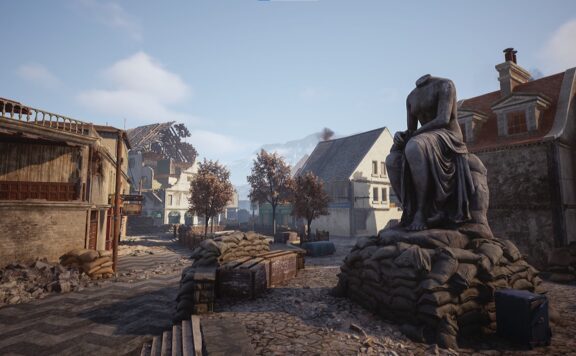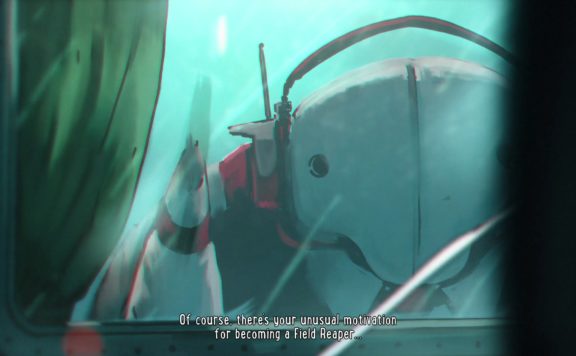Something dark stirs in the wilderness… ValeGuard is an independent game developed by Lost Tower Games where the player alternates between turn-based building management and real-time tactical combat against waves of various types of enemy. Not quite a tower defense, not quite a city builder, ValeGuard takes nods from a variety of sub-genres to develop its formula, which ends up largely paying off in the game’s favor.
I went into the game not expecting too much. It’s pretty clearly the work of a small team, and strategy-adjacent games developed by small teams are always a bit of a gamble. The graphics are simplistic – I’m not ashamed to say that the first thing I thought of when I saw the game’s cube-based terrain tiles was Minecraft, and non-hero infantry appear to be mostly little Minion-shaped fellas, mostly told apart by whatever weapon they happen to be carrying. Also, I at first figured the entire game was played on a single map that was small enough to fit on-screen with no scrolling, and I thought I was in for a slightly boring slog through My First Strategy Game. I decided to soldier on and ended up being pretty pleasantly surprised by what I came across.
Let’s take a look, shall we?

Concept and Formula
ValeGuard is a game that is entirely about defending towns against waves of monsters. The player, supposedly, takes on the role of one of these titular heroes: the ValeGuard. Wandering heroes with a knack for management, ValeGuards travel from hamlet to hamlet, helping the hapless inhabitants prepare themselves to hold off whatever demons, orcs, or undead (the 3 enemy faction types) might be threatening the little towns.
That’s pretty much the extent of the story, though it’s enough of a premise to work with. There’s not much in the way of *character* to the core game (though as we’ll see there are a couple of nice touches that spice things up a bit) and your heroes are relatively straightforward fantasy fare: Rangers, Paladin, and the like. Likewise, the units you can produce are pretty simple: spearmen, javelin throwers, berserkers, et cetera.
The core gameplay formula is simple: during the day, you assign orders to your city: issuing the construction of buildings, adding armor or horses to your units, and assigning your workers to tasks such as harvesting lumber, mining iron, tending to crops, building weapons, or building structures. Also, many maps have a map-specific structure that you can progress on: in one case there was a bridge that automatically conferred victory on the map when it was completed; there was one where there was a pumpkin patch that could give you food when you finished tending to it, but could also create waves of enemies. That sort of thing.

But, back to the core gameplay. So, during the day you’re asked to basically allocate your limited population to generating or spending resources: you need to spend gold and spears (as well as convert one of your limited stock of villagers, thereby limiting your economic output) to create spearmen. You need to commit workers to building projects, which means they can’t contribute to your economy that day.
Resources and Random Events
The game has a couple tradeoffs of this type, and while they’re largely pretty simple, they can be interesting to manage given the limited number of workers you have, compared to how many things you’d ideally like to do during the course of a single day. Effectively, you always have to plan a couple of turns ahead to set yourself up for success during the later turns of a level.
At night, you’re subjected to random events. These could be along the lines of “a mysterious visitor stops by your town, asking to stay the night. What do you do?” and a handful of options such as “let them stay” or “turn them away.” Letting the wanderer stay could give you an extra villager, or it could result in the loss of 50 Food as the traveler raids your stash.
Other events are a healing woman that stops by to top off your units’ health. A traveling blacksmith that will craft random items in exchange for Iron. Emergencies in the forest that take one of your squads for a day or 2 (and they might not return) or attacks.

That’s the real core of the game, of course. The attacks. They only happen every couple of turns, but they’re really what the game is all about. Everything else in the game is just there to get you ready for attacks, or to distract you from being prepared for an attack, or to require you to work around various and sundry setbacks and protracted, turns-long buildups before you have what you want… because of the impending attacks.
Turns themselves are a scarce resource: each mission will last 15, 20, 30-ish turns, and during that mission about 1/3 or ¼ of the turns will result in an attack. Earlier missions, of course, will space these out more and will present less challenging enemy types.
Combat and Scope
I never really felt challenged by the combat portion of the game. Enemies will attack units or structures, and it’s pretty bad to lose either of these, but only in 1 or 2 levels did I ever lose even a single building (not counting walls). During the day, you can build turrets that do things like: slow incoming enemies (freeze tower), spawn defensive melee units, shoot arrow, or buff your units in a small area.
For their cost, turrets seem to be a better investment than units in most cases, and also make less of an economic impact since they only consume workers during their construction. Enemies can only attack from ‘the mist’ which changes location every turn or so, but they’ll almost always walk right towards your Inn (the central structure of each town – you lose a mission of this, or all of your ValeGuards, die). Turret coverage isn’t difficult to maintain, and I typically built no more than 3-4 infantry per mission, where I’d build as many as 5-7 turrets.

Units are slightly clunky to control. Drag-selecting seems a bit… quirky, and it’s often the case where you’re just selecting everything you have and attack-moving towards one group of advancing enemies or another. Heroes have a single ability each and can carry one item each (some of which are active and some of which are passive). Heroes auto-target enemies at a longer range than non-hero units, and also move considerably faster than non-heroes. This led me, especially in later missions where you start with 4 or 5 hero units, to focus pretty exclusively on heroes and turrets with just a handful of other infantry for support.
As you complete missions, you are presented with a map and can select between a variety of other hamlets to defend. Each hamlet offers a ValeGuard type, a small resource boost, and a unit or building type unlock. Each hamlet you don’t defend is destroyed by the monsters, which feels a little harsh but I suppose adds to replay value. It would be interesting to me to have to assign different ValeGuards to each hamlet, which would increase mission difficulty and add more strategy to the game.
ValeGuard is actually pretty well scoped, I feel. The art is good enough to not be an eyesore when you’re playing (the day/night transition is well done if you’re playing on higher visual settings, but is mildly offputting at the lowest setting). The music is understated and actually pretty decent if a bit fantasy-generic. The system of forcing players to manage limited resources (there were a couple of times when I was perilously low on food, or when I didn’t have the gold to make more units) adds just enough challenge to make you feel like you’re accomplishing something, and forces you to actually plan ahead to do well in missions. The random events add a bit of challenge too: there were levels where I was desperately waiting for the healing woman to come by so I didn’t lose units or levels where I cursed the trading cart for coming too early or too late, or when I took a gamble on a quest and lost units or most of my stock of a resource.

The game could do with a bit of balance, both in terms of unit/turret tradeoffs, and rewards. Later missions were absurdly generous with rewards, allowing me to stockpile my way out of most of the challenge of the game in one or two cases. Even randomly losing 50 Food or so isn’t that bad when you have 350 stocked up (for reference, each unit and worker consumes 1 food per turn, and horses consume something like 5 each).
Note: A copy was provided by the developer for review purposes.






